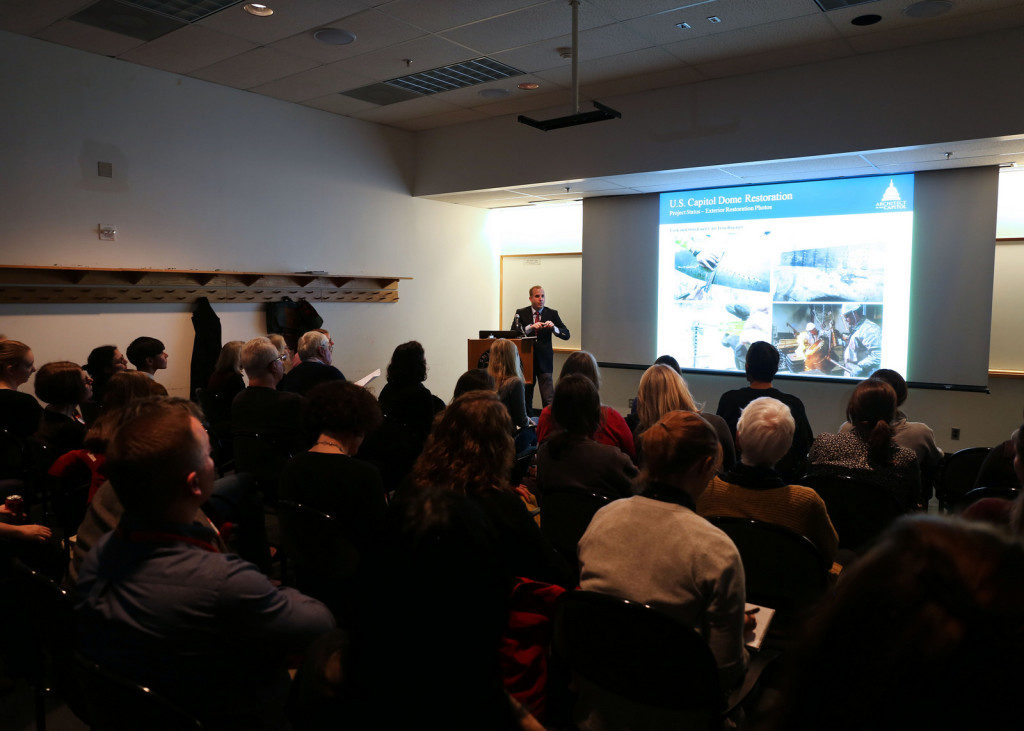At the January 3 Ring Circus, as part of Ring # 3 (BIG Conservation), Joseph Abriatis, Construction Manager at Architect of the Capitol, presented a lecture on the restoration of the capitol building dome. The dome was built over 150 years ago and was last restored in 1959-60.

The current restoration of the dome is now in Phase II, which has three parts, all of which are currently underway. The focus of this talk was Phase IIA, the restoration of the exterior cast iron dome. Restoration of the interior and rotunda are also underway, but were not discussed in this talk.
The restoration of the exterior dome began in June 2014, with the installation of 1.2 million pounds of scaffolding, equivalent to 52 miles of components! The twenty-five stories of scaffolding are attached at only three levels – levels eight and above are self-supported.
The first step was the removal of many layers of lead white paint, added during the last restoration campaign in 1960. The paint was removed using abrasive blasting with copper slag. Containment areas, under negative pressure, were set up to capture the dust for proper disposal. Some of the more intricate decorative elements were removed for cleaning. Once cleaned, the surface must be promptly coated with a primer as the cast iron will quickly flash rust if left uncoated.
The next step was repairing thousands of inches of documented cracks in the cast iron structure. These allow water and moisture to penetrate, causing rust, corrosion, and structural damage. During the last restoration campaign in 1959-1960, cracks in the cast iron were repaired by welding. Cast iron is not easily welded in an outdoor environment as obtaining a good weld requires controlled heating and cooling, and tempering, so that it doesn’t become brittle. Many of these repairs previous have since failed, often causing additional cracking radiating out from the original crack. During the current restoration campaign, a different strategy, called metal stitching was employed. Metal stitching is a mechanical repair used to repair engine blocks in cruise ships. Abriatis passed around many samples to help attendees to understand the process. First, a series of holes is drilled along the crack. Then, drills and jigs are used to create a dog-bone pattern perpendicular to the crack. Steel pins are inserted to stabilize the crack, and steel braces are inserted to hold the crack together. Once the pins are inserted and the surface is sanded down and painted over, the repair is invisible.
The next step was recasting missing and irreparably damaged components. The largest such project was the disassembly of the balustrade. It was in poor shape, with corroded gutters. The balustrade was disassembled and shipped to Salt lake City, Utah, where all broken and missing pieces were recast. Many other decorative elements were also recast and replaced.
The next big project was the window restoration of the cupola, which was done by a Portland-based firm. The original 1860s windows were very large and heavy – about 200 lbs each, and were made of float glass, which has wavy appearance, like shower glass. The method used to make the replacement glass was similar to the process that would originally have been used and is much closer to the original appearance than the1950’s repairs. Abriatis showed a short video clip at the end of the session, which illustrated the glass-making process. It can be found on Youtube: https://www.youtube.com/watch?v=ddMqr0y1KkU&feature=youtu.be&list=PLAyjFo-S4AOr9nucrlx54stiOYzSo-Ybv
The restoration of the cast iron dome has now progressed to the final step, application of the finishing paint to the structure. More information on the restoration of the dome is available on the Architect of the Capital website at: http://www.aoc.gov/dome/project-overview
Summarized by Stephanie Barnes
NMAAHC/MCI Paintings Conservation Fellow